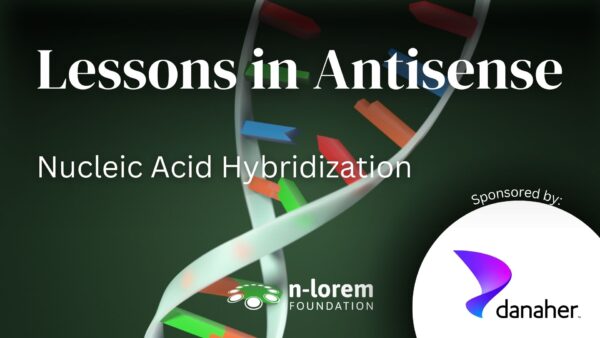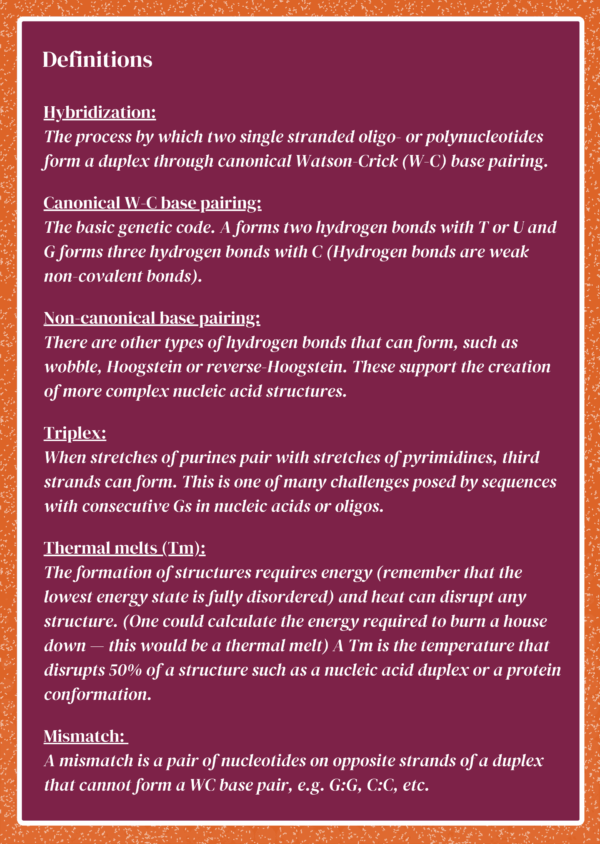Lessons in Antisense
Lesson 3 – Nucleic Acid Hybridization
April 28, 2025 by Dr. Stan Crooke

Introduction
The formation of a nucleic acid duplex is energetically unfavorable, and the rate-limiting step is the formation of the first few base pairs (nucleation). Once a few base pairs (3-5) are formed, the rest of the duplex is “zippered up”.
This means that hybridization is a very slow process compared to other chemical reactions, and if a 1:1 molar ratio of strands is used, very little duplex will form. Even at a 20:1 molar ratio, equilibrium is not achieved for many hours. Thus, for Tm measurements, one typically forms a duplex by having one strand in great excess. The Tm is then measured by increasing the temperature. The higher the Tm — the stabler the duplex.
Caveat: I am not an expert in hybridization.

Mismatches destabilize duplexes
Think of a duplex as a zipper. If two of the teeth in a zipper don’t work, the zipper may break. The extent of destabilization of a mismatch varies by position in a duplex. Mismatches in the center of a duplex are more destabilizing than at the ends.
G:C mismatches are more destabilizing than A:T for the same reason that G:C pairs are more stable — that is, there are 3 vs 2 hydrogen bonds.
The theoretical difference in maximum selectivity induced by a single mismatch in a 20-mer ASO:RNA duplex is fivefold.
Increasing the rate of hybridization
The simplest way to increase the rate of duplex formation is to reduce the entropic barrier by fixing one strand in two rather than three dimensions. For example, this is why nucleic acid probes are usually fixed. In the cell, this is accomplished by DNA and RNA existing in aggregates that can undergo phase separation or be localized within membranes.
A host of nucleic acid-binding proteins are used to facilitate hybridization in cells, including many helicases that use adenosine triphosphate (ATP) hydrolysis to provide the energy needed.
ASOs could not work if there were not proteins and lipids that facilitate hybridization. My lab searched for such proteins and lipids for years and never found an ASO hybridization “facilitator”. I suspect that is because the reaction is facilitated by RNA-Protein complexes rather than a single protein or lipid.
The slow kinetics of the hybridization of ASOs to cognate RNA sequences is one reason that ASO effects are very slow developing. My lab worked out the kinetics and, roughly speaking, it takes about 60 minutes for PS ASOs to enter cells and distribute to active sites, 20 minutes to hybridize, and 40 minutes to recruit RNAse H1 and accumulate enough cleavages to measure.
Conclusions
Cells use polymers like DNA, RNA, and proteins to store and use complex information. ASOs are nucleic acid oligomers, meaning they comprise of a few (16-20) nucleotides designed to take advantage of the genetic code to identify cognate sequences in RNA. Theoretical calculations that have been validated experimentally suggested that 16 nucleotide or longer ASOs could discriminate a single mismatch and thus be very specific for the target RNA for which each ASO is designed.
The process that leads to binding of oligo-or-polynucleotides Watson and Crick hydrogen bonding is called hybridization. Though the interaction of one nucleotide with another is weak, when an ASO-RNA duplex is formed, the binding of the ASO to RNA is very strong because, like a zipper, multiple nucleotides contribute. Once again, the formation of an ASO-RNA duplex is zipper-like in that the first step (nucleation) is the binding of a few nucleotides between the ASO and RNA. Then, the rest of the nucleotides bind relatively rapidly. This means that the formation of an ASO-RNA duplex is slow but, once formed, quite stable. So, not only is it possible for an ASO to identify its target RNA quite specifically in cells with vast numbers of RNA, but the affinity of the ASO for the target RNA is high.
By use of the medicinal chemistry of ASOs, we can design ASOs that bind RNAs even more avidly than natural RNA, thus enhancing affinity and the potency of the ASO. However, binding of an ASO to a target RNA is much slower than the rates with which other types of drugs bind to their receptors. Though we have not identified the cellular proteins or lipids that may be involved in facilitation ASO-RNA hybridization, we believe that it is likely that ASO-RNA hybridization is facilitated in cells.

We cannot do
this alone
Together we are changing the world—
one patient at a time
We hope that you join us on this journey to discover, develop and provide individualized antisense medicines for free for life for nano-rare patients. The ultimate personalized medicine approach – for free, for life.
Follow us on social for updates on our latest efforts


